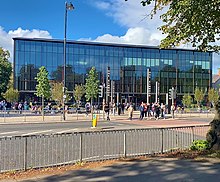
The Queen's University of Belfast, commonly known as Queen's University Belfast, is a public research university in Belfast, Northern Ireland, United Kingdom. The university received its charter in 1845 as "Queen's College, Belfast", and opened four years later.

Mark Durkan is a retired Irish nationalist politician from Northern Ireland. Durkan was the deputy First Minister of Northern Ireland from November 2001 to October 2002, and the Leader of the Social Democratic and Labour Party (SDLP) from 2001 to 2010. He contested the Dublin constituency for Fine Gael at the 2019 European Parliament election.

Union Theological College is the theological college for the Presbyterian Church in Ireland and is situated in Belfast, Northern Ireland. It is governed by the Council for Training in Ministry. It has been responsible for training people for ministry in the Presbyterian Church in Ireland and also runs courses open to the wider public, including distance learning courses offered through BibleMesh.

Edinburgh University Students' Association (EUSA) is the students' union at the University of Edinburgh, Scotland. The Association's aim is the advancement of education of Edinburgh students by representing and supporting them, and by promoting their interests, health and welfare within the community. It is led by a team of five elected student sabbatical officers.
The Glasgow University Students' Representative Council, also known simply as the Students' Representative Council or by the acronyms GUSRC and SRC is a student union at the University of Glasgow. Unlike at other universities in the United Kingdom, the University of Glasgow operates a unique system, with four separate and independent bodies providing services to the student body. In contrast with the Glasgow University Union, Queen Margaret Union, and Glasgow University Sports Association, which provide social and sporting facilities for their members respectively, the SRC is responsible for representing the views and interests of the student body to the University.

The Union of Students in Ireland (USI) is the national representative body for third-level students' unions in Ireland. Founded in 1959, USI represents more than 374,000 students in over forty colleges across the island of Ireland. Its mission is to work for rights of students and a fair and equal third level education system in Ireland.

NUS-USI, the student movement in Northern Ireland, was formed in 1972 by bilateral agreement between the National Union of Students of the United Kingdom (NUS) and the Union of Students in Ireland (USI), to address the particular problems of representing students in Northern Ireland. As of 2018, NUS-USI represented approximately 200,000 students in the region.

Sir Charles Lanyon DL, JP was an English architect of the 19th century. His work is most closely associated with Belfast, Northern Ireland.

The University of St Andrews Students' Association is the organisation which represents the student body of the University of St Andrews. It was founded in 1885 and comprises the students' representative council and the Student Activities Forum.
A students' representative council, also known as a students' administrative council, represents student interests in the government of a university, school or other educational institution. Generally the SRC forms part of a broader students' association, which may include other functions such as societies, entertainments and sports. They are most commonly found in Scottish universities.

Queen's Quarter is the southernmost quarter in Belfast, Northern Ireland and named after Queen's University Belfast, Northern Ireland's largest university. The Quarter is centred on the Lanyon Building, the University's most prominent building, designed by architect Sir Charles Lanyon, while Botanic Avenue, Stranmillis Road, University Road and Malone Road are the main thoroughfares through the area. The Quarter encompasses a region bounded by the Ormeau Road, the Holylands and Stranmillis Embankment to the east and the Lisburn Road to the west.

Queen's Radio is a student radio station, broadcasting a wide variety of shows, based at Queen's University, Belfast, Northern Ireland, currently broadcasting via online stream.
Aberdeen University Students' Association is the students' association of the University of Aberdeen, an ancient university in the city of Aberdeen in North East Scotland. It organises recreational activities; provides welfare and employment services for students; promotes equality and diversity of students; advancement of education; and provide facilities and support for student societies and sports clubs.

An Cumann Gaelach is the Irish Language Society at Queen's University Belfast. Established in 1906, it is the third oldest society still in existence at the University, after the BMSA and Christian Union. The first meeting of the society was held on 30 January 1906, with William Mac Arthur being elected the first president. The society is part funded by the University, through the QUB Students' Union.
In universities in the United Kingdom students' unions are constituted under Section 2 of the Education Act 1994. The ultimate purpose of students' unions is to democratically represent the interests of their members. Students who resign their membership may still use union social facilities provided since they are for the benefit of the students of the institution, not just union members. The vast majority of UK students' unions are affiliated with the National Union of Students (NUS).

The Irish Baptist College (IBC) is a Baptist theological college in Moira, Craigavon, Northern Ireland. It is affiliated with the Association of Baptist Churches in Ireland. It is part of the Baptist Theological Centre which is located in the Baptist Centre and is shared with ABC. IBC is accredited and reached Premier College Status by the Accreditation Service for International Colleges (ASIC). The Quality Assurance Agency for Higher Education of England and Wales, review the IBC for quality and standards.

Elmwood Hall is a concert hall and former Presbyterian Church on University Road in Belfast, Northern Ireland. It is situated opposite Queen's University Belfast.
The Literary and Scientific Society of the Queen's University of Belfast is the university's debating society. The purposes of the Society, as per its Laws are to "encourage debating, oratory and rhetoric throughout the student body of the University and beyond".















